
New tools and techniques can be transformative. Last year proved this time and again, as researchers took the first picture of the Milky Way Galaxy with particles instead of photons and an innovative team turned stellar corpses across the galaxy into one big gravitational-wave detector capable of tuning into the background “hum” of our cosmos. Among the many stunning results from the groundbreaking James Webb Space Telescope, new finds began to challenge astronomers’ picture of the early universe.
There was plenty of excitement closer to home, too. Numerous comets sent skywatchers and astrophotographers rushing outside, while eager planetary scientists finally got their hands on the largest sample ever returned to Earth from a carbon-rich asteroid. And an annular eclipse across the Americas set the stage for totality in April 2024. Overall, 2023 was an exciting year of discovery that proved that patience, ingenuity, and vision can offer amazing payoffs.
OSIRIS-REx delivered its payload — and then some
Our February 2022 Top 10 list notes that on May 10, 2021, NASA’s Origins, Spectral Interpretation, Resource Identification, Security-Regolith Explorer (OSIRIS-REx) mission had turned toward home following its collection of material from the near-Earth asteroid Bennu.
Last year, that effort came to fruition. Just before 9 a.m. MDT on Sept. 24, 2023, a beautiful sight appeared in the skies above Utah: the craft’s sample-return capsule (SRC) safely falling to Earth beneath its broad, orange-and-white striped parachute. The capsule, which had been released just hours earlier when the spacecraft was 63,000 miles (102,000 kilometers) from Earth, landed on target at the U.S. Air Force’s Utah Test and Training Range.
The next day, the SRC flew via cargo plane to NASA’s Johnson Space Center in Houston, where a team waited to catalog and disassemble the canister and its attached sampling mechanism, called the Touch-and-Go Sample Acquisition Mechanism (TAGSAM). These were first placed inside sealed “gloveboxes,” preventing the samples from being exposed to Earth’s atmosphere.
It was slow going: The TAGSAM and canister lid were coated in so much extra material that collecting and cataloging it before the canister itself could be accessed required exquisite care. It was “the very best ‘problem’ to have,” said deputy OSIRIS-REx curation lead Christopher Snead in a statement. It’s also a “problem” that researchers had anticipated, given the material seen overflowing from the TAGSAM head following the collection maneuver Oct. 20, 2020, when the TAGSAM sank some 20 inches (50 centimeters) into the asteroid.
By Oct. 11, 2023, NASA hadn’t yet opened the canister. But the agency revealed the results of an initial analysis of the excess material: Bennu is rich in carbon and hydrated clays, compounds that contain significant water. This means organic molecules — the building blocks of life — may also be present. Researchers also found sulfides, a necessary component of amino acids. These results bode well for scientists interested in the abundance and role of such materials in the early solar system and the development of life on Earth — and potentially elsewhere. Asteroids provide the perfect starting point for study, as they both contain pristine material that dates to the solar system’s birth and are thought to be the main vehicle for delivering many elements, including water, to the young Earth.
NASA collected 2.48 ounces (70.3 grams) from the hardware alone, exceeding the mission’s goal of retrieving 2.12 ounces (60 g) from Bennu before the sample proper was ever accessed. And with its precious cargo dropped off, the spacecraft is now headed to the near-Earth asteroid Apophis, which it will study up close starting in April 2029. Accordingly, the craft has a new name: OSIRIS-APEX, for APophis EXplorer.
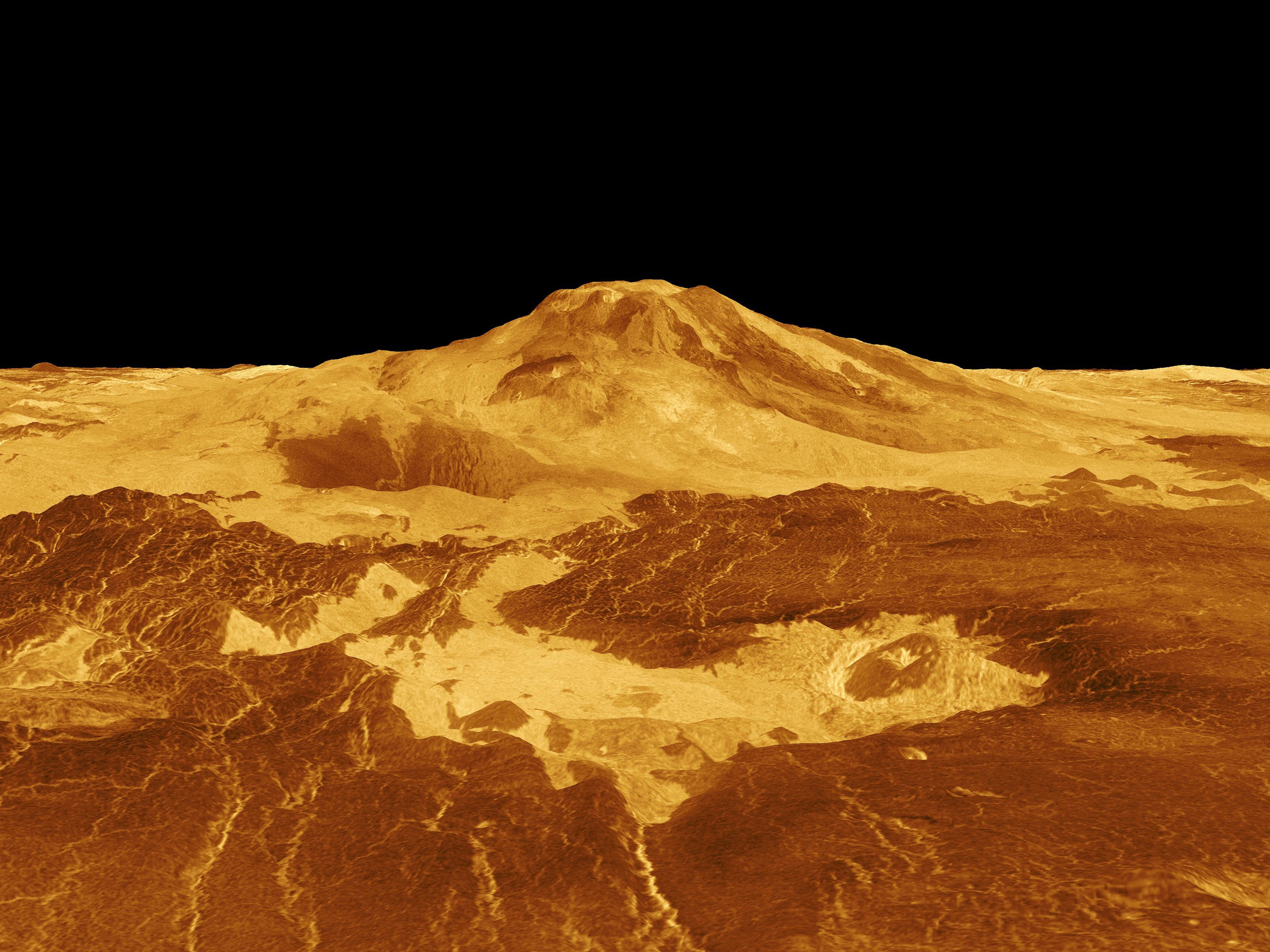
A volcano may have erupted on Venus in 1991
Planetary scientists are looking forward to the wealth of future data from Venus, with several missions preparing to visit the world in the coming years. But new discoveries are still hiding within older, existing data, as a March 15 Science study proved.
In it, researchers examined some 200 hours of radar observations of Venus’ surface taken by the Magellan spacecraft, which orbited the world from 1990 to 1994, mapping the entire surface. By looking for changes between different orbits, the team spotted direct evidence — the first ever seen — of recent volcanic activity on Venus.
“I saw two images of the same region taken eight months apart exhibiting telltale geological changes caused by an eruption,” explained Robert Herrick of the University of Alaska Fairbanks, who led the study, in a press release.
The images featured a region near Venus’ equator that hosts some of the planet’s largest volcanoes, including Maat Mons. Herrick spotted changes that occurred between February and October 1991 in a vent on the volcano’s lower slopes. When compared with the earlier images, the October data showed that the previously circular vent had roughly doubled in size and become distorted in shape. It also seemed to have filled with lava, with some even flowing downhill, away from the vent.
This analysis was no simple task. The data resolution was low and the images had been taken from different angles. Comparing them required modeling the vent to explore all possible explanations, including passive landslides. But ultimately, “only a couple of the simulations matched the imagery, and the most likely scenario is that volcanic activity occurred on Venus’ surface during Magellan’s mission,” said study co-author Scott Hensley of NASA’s Jet Propulsion Laboratory, an expert in analyzing radar data. Provided their interpretation is correct, then, “it confirms there is modern geological activity” on Venus, he said.
The idea has far-reaching implications. Venus has more volcanoes than any other planet, but scientists previously believed none were active over the past billion years. If one volcano is still active, why not more? The more we study Earth’s twin, the more we find there is still much to learn about how rocky planets form and evolve.
Astronomers identify a possible magnetar precursor
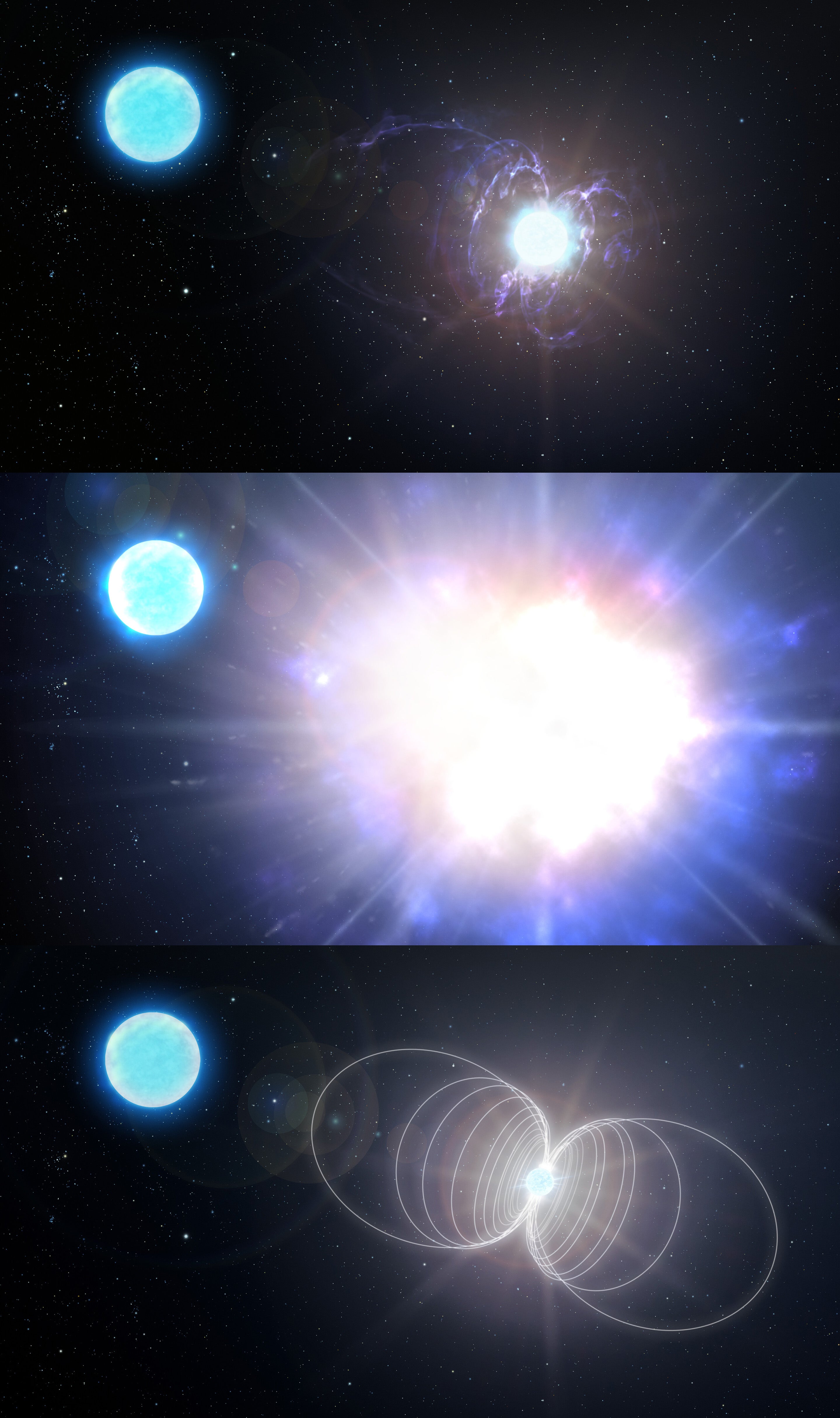
Magnetars are objects with magnetic fields a thousand trillion times stronger than Earth’s. They are a subclass of neutron stars, the remnants of massive stars. But while astronomers known how run-of-the-mill neutron stars are formed, they aren’t sure yet of the specific conditions that create a magnetar, whose magnetic field is some 100 to 1,000 times stronger than a neutron star’s.
At least part of the answer might lie in a star called HD 45166, the subject of a paper published Aug. 17 in Science. HD 45166 is a Wolf-Rayet star; these massive, helium-rich stars typically weigh 25 times the mass of the Sun and blast out powerful winds of charged particles. Because of their high mass, they rapidly fuse hydrogen into helium in their cores, living for a fraction of the Sun’s lifetime before exploding as supernovae and leaving behind neutron stars or black holes.
But HD 45166 is an oddball among Wolf-Rayets at only 2 solar masses — a real lightweight. And its magnetic field has a strength of 43 kilogauss, or 100,000 times stronger than Earth’s magnetic field. That makes it the most magnetic massive star ever found.
“We’ve never detected a magnetic field in a massive helium star that will undergo core collapse [a type of supernova],” says study leader Tomer Shenar of the University of Amsterdam. “It’s really a new type of star.” Shenar and his colleagues think HD 45166 didn’t evolve the way other Wolf-Rayets do (as part of some massive stars’ life cycles), but perhaps as the product of a merger between two other more intermediate-mass helium-rich stars.
Despite the staggering strength of HD 45166’s magnetic field, it is still 10 billion times below that of a magnetar. But in a few million years, when HD 45166 explodes as a supernova and leaves behind a neutron star, its magnetic field will be confined to a region just 12 miles (20 km) across — the size of a typical neutron star. Because magnetic flux is conserved, compressing the field will boost its strength by about 10 billion times, creating a magnetar.
“We thought that the most likely magnetar candidates would come from the most massive of stars,” said study co-author André-Nicolas Chené of the National Science Foundation’s National Optical-Infrared Astronomy Research Laboratory in Hilo, Hawaii, in a statement. “What this research shows us is that stars that are much less massive can still become a magnetar, if the conditions are just right.”
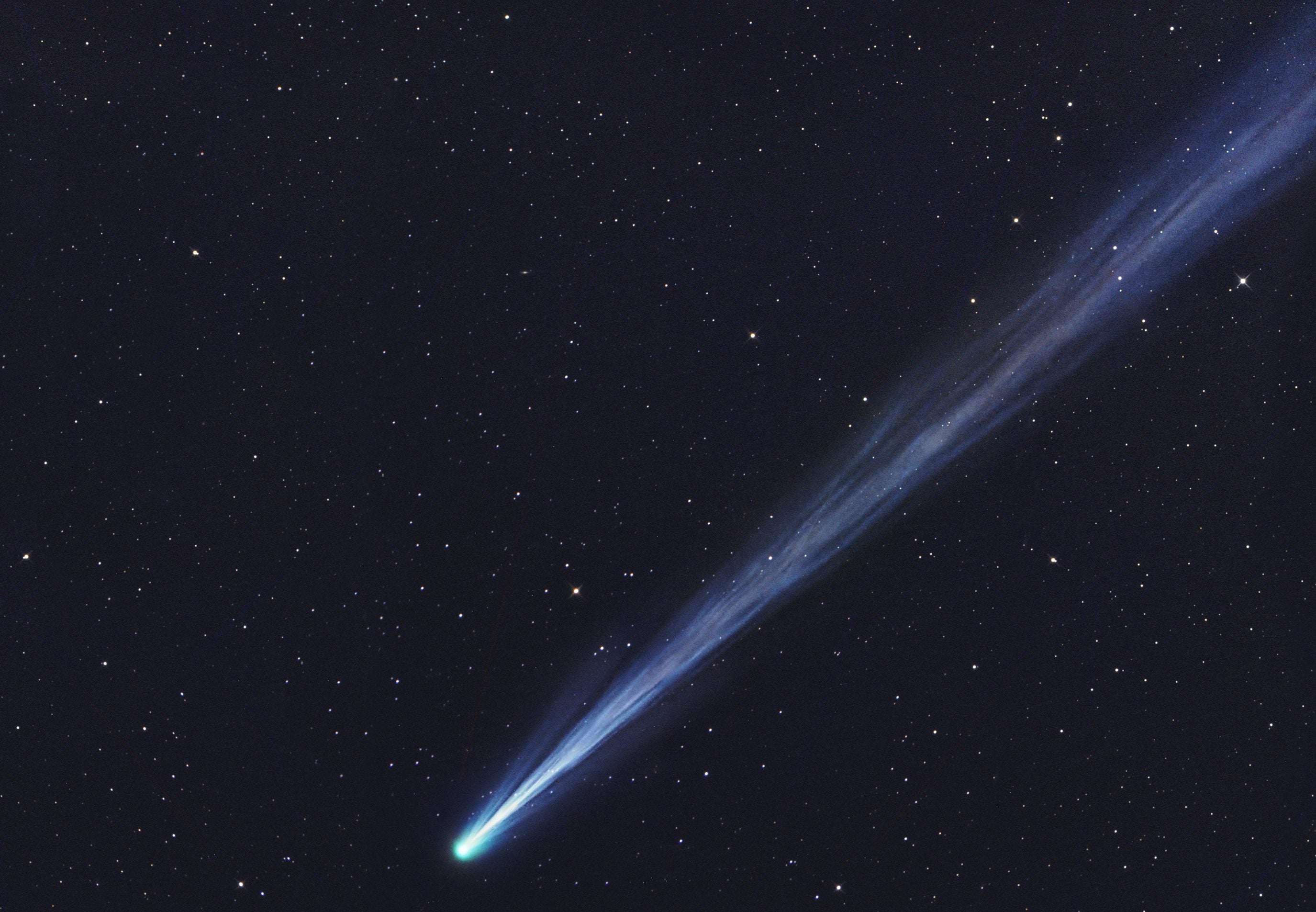
Cometary surprises delight
Comets are notoriously unpredictable. In 2023, that worked in our favor, with three particularly notable comets stealing attention.
The year opened with what we expected to be its best comet: C/2022 E3 (ZTF), which reached perihelion — the closest point to the Sun in its orbit — on Jan. 12. On Feb. 1, ZTF passed closest to Earth, coming within about 0.3 astronomical unit of our planet. (One astronomical unit, or AU, is the average Earth-Sun distance.) During its visit, ZTF ultimately reached magnitude 4.5 and developed a well-defined anti-tail seen in many photographs.
Magnitude 4.5 is also the brightness our next visitor, 12P/Pons-Brooks, is expected to reach in April this year, weeks before perihelion. That’s when, as first noted by amateur astronomer Dave Weixelman, it will appear some 24.5° from the Sun during the total solar eclipse April 8.
But Pons-Brooks wasn’t willing to wait for fame. On July 20, 2023, observer Elek Tamás went looking for the then-magnitude 16.6 comet — and discovered an outburst had catapulted it to magnitude 11.6. By early October, the comet had faded only slightly — and underwent a second outburst Oct. 5, reaching roughly the same magnitude as in July. Both times, the comet displayed a unique “horned” or horseshoe shape, earning it the nickname “devil comet.” According to comet researcher Richard Miles (who spotted the second outburst), Pons-Brooks has had similar flare-ups during past visits to the inner solar system. Perhaps it’s had yet another since this issue went to press!
Avid skywatchers already know we’ve saved the best for last: Comet ZTF was not 2023’s best. That title goes to C/2023 P1 (Nishimura), which burst onto the scene Aug. 12 when Japanese amateur astronomer Hideo Nishimura of Kakegawa, Japan, spotted it in Gemini, already at magnitude 10.4 and 1 AU from the Sun. Nishimura passed closest to Earth a month later, before rounding the Sun at a perihelion distance of just 0.23 AU on Sept. 17, peaking at an impressive magnitude 2.5. After perihelion, it disappeared from Northern Hemisphere skies and could only be picked up below the equator as it faded quickly on its way back to the outer solar system.
Its appearance was brief and it was never an easy naked-eye object due to its low elevation. Nonetheless, Nishimura was the definitive winner of 2023’s cometary crown.
An annular eclipse crosses the Americas
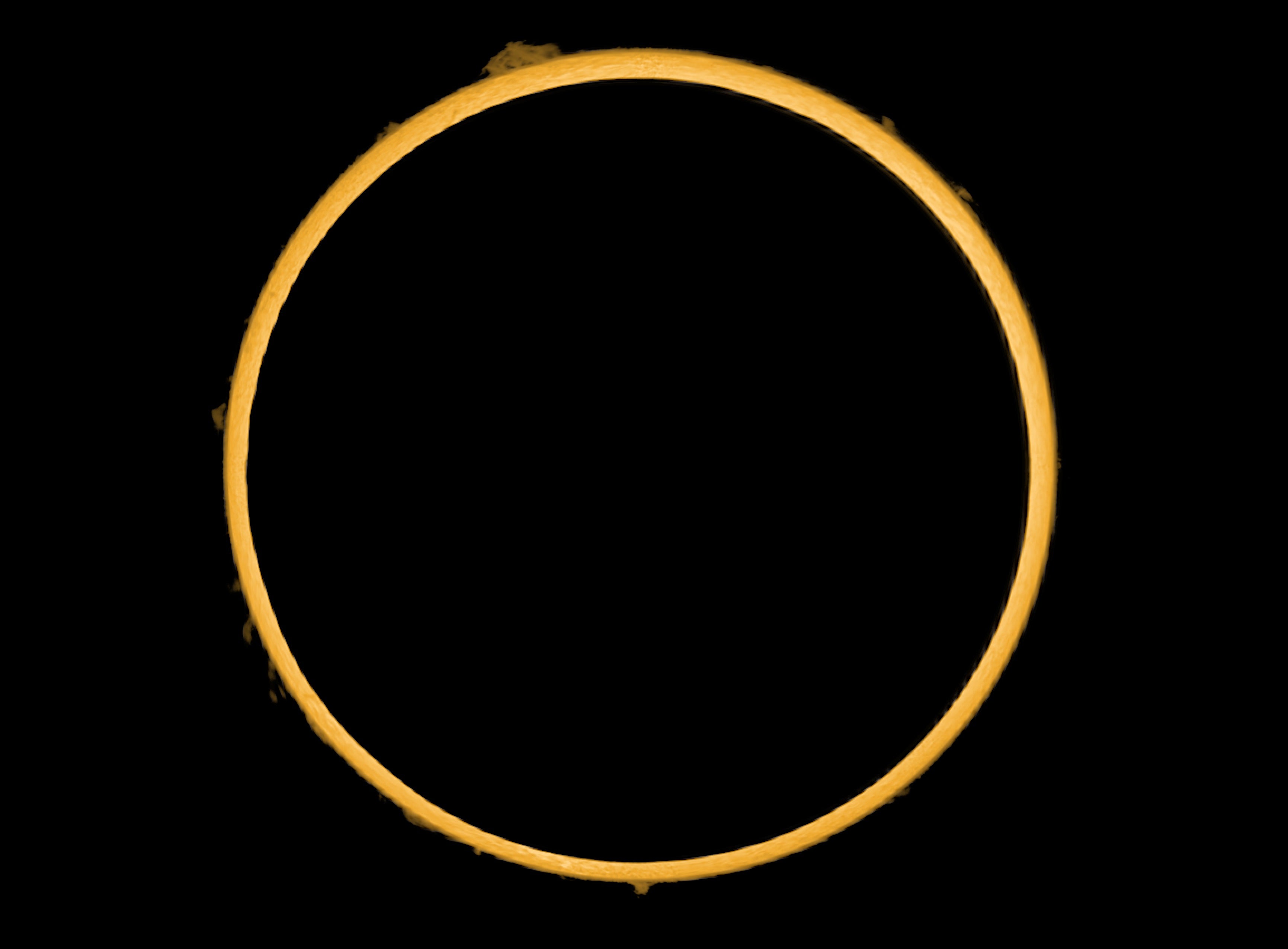
On Oct. 14, an annular solar eclipse crossed parts of North, Central, and South America. Although many considered the event a “preview” of 2024’s total eclipse, October’s annular eclipse was more than just a prelude. It was stunning in its own right, a once-in-a-lifetime event for millions of people that offered its own unique reward.
While a total solar eclipse lets earthbound observers glimpse the Sun’s outer atmosphere, called the corona, an annular solar eclipse occurs when the Moon is too far from Earth to cover the Sun’s disk completely. A thin sliver of the solar disk is left around the Moon, often called the ring of fire.
October’s ring of fire began in the Pacific Ocean before moving from Oregon through Texas as the first U.S. annular eclipse in more than a decade. The next will not occur until 2041. Some 6.6 million Americans lived in the path of annularity, with roughly half that number in Texas alone. Millions more lived within just a few hundred miles of the center line. Observers beneath the shadow experienced some four-plus minutes of annularity, with parts of Texas seeing nearly five minutes.
After leaving Texas, the eclipse passed through parts of Mexico, Central America, Colombia, and Brazil, finally ending over the Atlantic Ocean.
Eclipses offer unique opportunities for science, both on the ground and above it. For instance, NASA launched three sounding rockets from New Mexico — one before, one during, and one after the eclipse — as part of the Atmospheric Perturbations around the Eclipse Path mission to study how eclipses affect Earth’s upper atmosphere, particularly the ionosphere. This region is affected by variations in sunlight when the Sun naturally sets or rises, changing the amount of incoming ultraviolet radiation that can alter the properties of the atoms there.
If October’s annular eclipse whetted your appetite, you’re in luck — a total solar eclipse will soon cross North America, bringing the Moon’s shadow back to Earth along a path that includes the homes and businesses of 31.6 million Americans. With millions more again within driving distance, April 8 is sure to be one of 2024’s most noteworthy dates.
AI aids the search for planets … and life
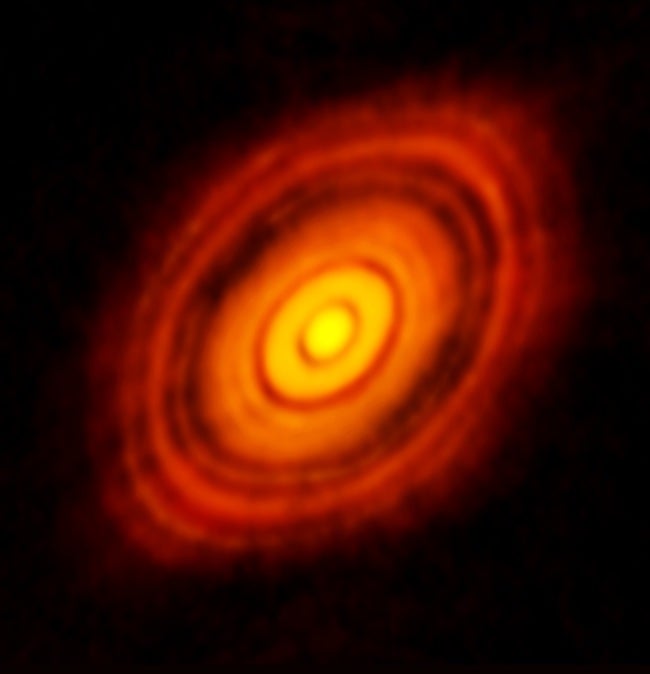
Headlines in 2023 were often dominated by the way AI is changing our world. And although the use of machine-learning tools in astronomy isn’t new, the practice began to see more attention in 2023 (including a feature in our July issue).
A Jan. 30, 2023, paper in Nature Astronomy showed how scientists searching for alien civilizations used AI to sift through nearly 500 hours of radio signals from over 800 stars. They were looking for patterns that couldn’t be natural, while throwing out interference from human technology. The algorithm pared down nearly 3 million events to just 20,515, which were examined by eye to ultimately identify eight possible technosignatures — signs of a technologically advanced civilization — from five stars. The signals were not seen when these stars were re-observed — so we haven’t found aliens yet. But the researchers noted the technique had fulfilled its purpose by identifying specific signals for follow-up.
An April 21 paper in The Astrophysical Journal showed that machine-learning tools can identify planets forming in the disk of dust and gas around a star. A team led by Jason Terry of the University of Georgia in Athens developed an algorithm to search images for the subtle signs of fledgling planets, which affect the orbit of nearby material and eventually carve out gaps in the disk. Not only did their model “rediscover” known planets, it also flagged a planet around the star HD 142666 that researchers hadn’t spotted. Terry’s team followed up and confirmed a likely forming planet there, demonstrating the model’s potential. “We think there will be an important place for these types of techniques as our datasets get even larger,” Terry said in a press release.
On Sept. 25, a paper in Proceedings of the National Academy of Sciences presented a machine-learning algorithm that could determine whether a sample of material was produced by life or through natural (abiotic) processes. And it could do so with 90 percent accuracy. The technique can be applied with existing technology and used on future space missions — or trace the history of ancient life on Earth.
These are just highlights from a year filled with AI-assisted discoveries. There will doubtless be many more in the years to come.
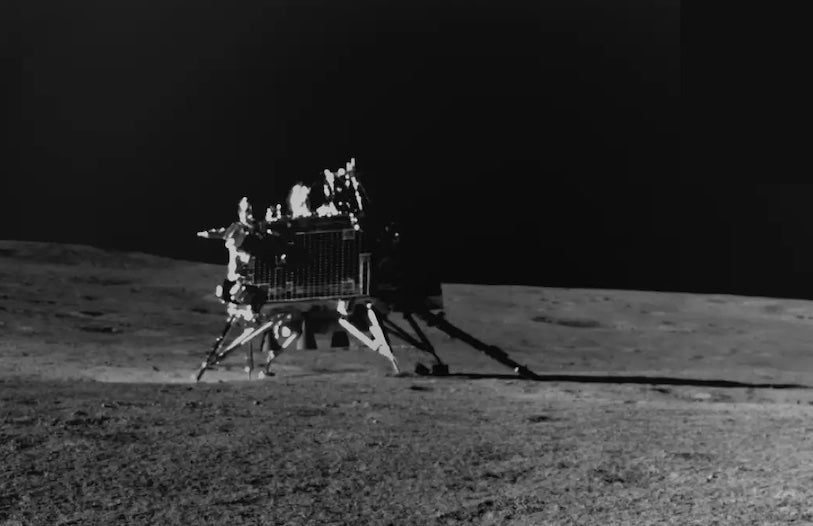
Lunar hits and misses
In late 2022, NASA’s uncrewed Artemis I successfully completed its trip around the Moon, splashing down Dec. 11 that year. Spending about a month in flight, the mission largely served as a test of the new Space Launch System rocket and Orion crew spacecraft. Now, NASA is gearing up for Artemis II, scheduled to launch in November 2024 for a 10-day round-the-Moon flight. On April 3, 2023, the agency announced the mission’s crew: NASA astronauts Reid Wiseman, Victor Glover, and Christina Koch, and Canadian Space Agency astronaut Jeremy Hansen.
But the U.S. isn’t the only one with eyes on the lunar prize. On Aug. 23, 2023, India became the fourth country to successfully land on the Moon when its Chandrayaan-3 mission touched down some 370 miles (600 km) from the lunar south pole, the closest landing to the pole to date. NASA is targeting this coveted region for its crewed Artemis III landing, as the terrain there may contain water ice useful for fuel and other needs.
One day after landing, India’s 3-foot-long (90 centimeters), 60-pound (27 kilograms), solar-powered Pragyan rover rolled out of the Vikram lander. For two weeks, the pair studied the lunar surface, even detecting a possible moonquake Aug. 26. Both went into sleep mode for the coming lunar night, also two weeks long. Neither craft had been designed to withstand the frigid temperatures of nighttime on the Moon; nonetheless, the mission team hoped they would reawaken when day broke over the landing site Sept. 22. But by Oct. 6, the team had received no communications, and back-burnered further attempts at contact. Nonetheless, the mission was a rousing success for the Indian Space Research Organisation (ISRO).
Not all lunar stories last year were successes. Russia’s Luna 25 lander, also targeting the lunar pole, crashed into the Moon Aug. 19. A few days later, Roscosmos cited an engine malfunction that caused the engines to burn too long while orienting the craft for landing. The lander was Russia’s first lunar mission in nearly five decades. The agency said it planned to accelerate its next two lunar missions, Luna 26 and 27, in response to the failure. Both are set to launch later this decade. And earlier in the year, Japanese startup ispace attempted the first commercial lunar soft landing, targeting Mare Frigoris’ Atlas Crater with the HAKUTO-R Mission 1 Lunar Lander. Although the craft was in good shape on approach, it did not send confirmation of touchdown after the scheduled landing time on April 25. Shortly after, mission engineers determined its propellant likely ran out, causing the lander to crash.
All this goes to show that landing even uncrewed craft on the Moon is far from easy or routine, and many challenges still await both robotic and human explorers.
India’s second success story
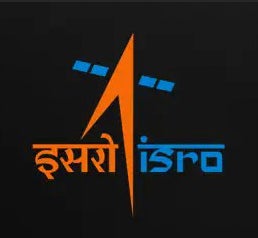
Shortly after Chandrayaan-3’s landing, India successfully launched its Aditya-L1 mission to study the Sun on Sept. 2. Originally conceived in 2008 as a small Earth-orbiting satellite, the craft evolved into a five-year-long mission that will orbit the Sun at Lagrange point 1 (also called L1), about 900,000 miles (1.5 million km) from Earth. There, it will continuously monitor our star with a payload of seven instruments, providing unique views not available on other solar missions, such as multiwavelength observations near the solar limb and images in previously unobserved ultraviolet wavelengths. Overall, Aditya-L1 aims to answer questions about the Sun’s super-hot outer atmosphere, the corona, as well as how the star’s magnetic field generates space weather and affects our atmosphere here on Earth.
Both Aditya-L1 and Chandrayaan-3 are testaments to the country’s efforts in recent years to ramp up its space program and become a major player capable of interplanetary missions for new discoveries.
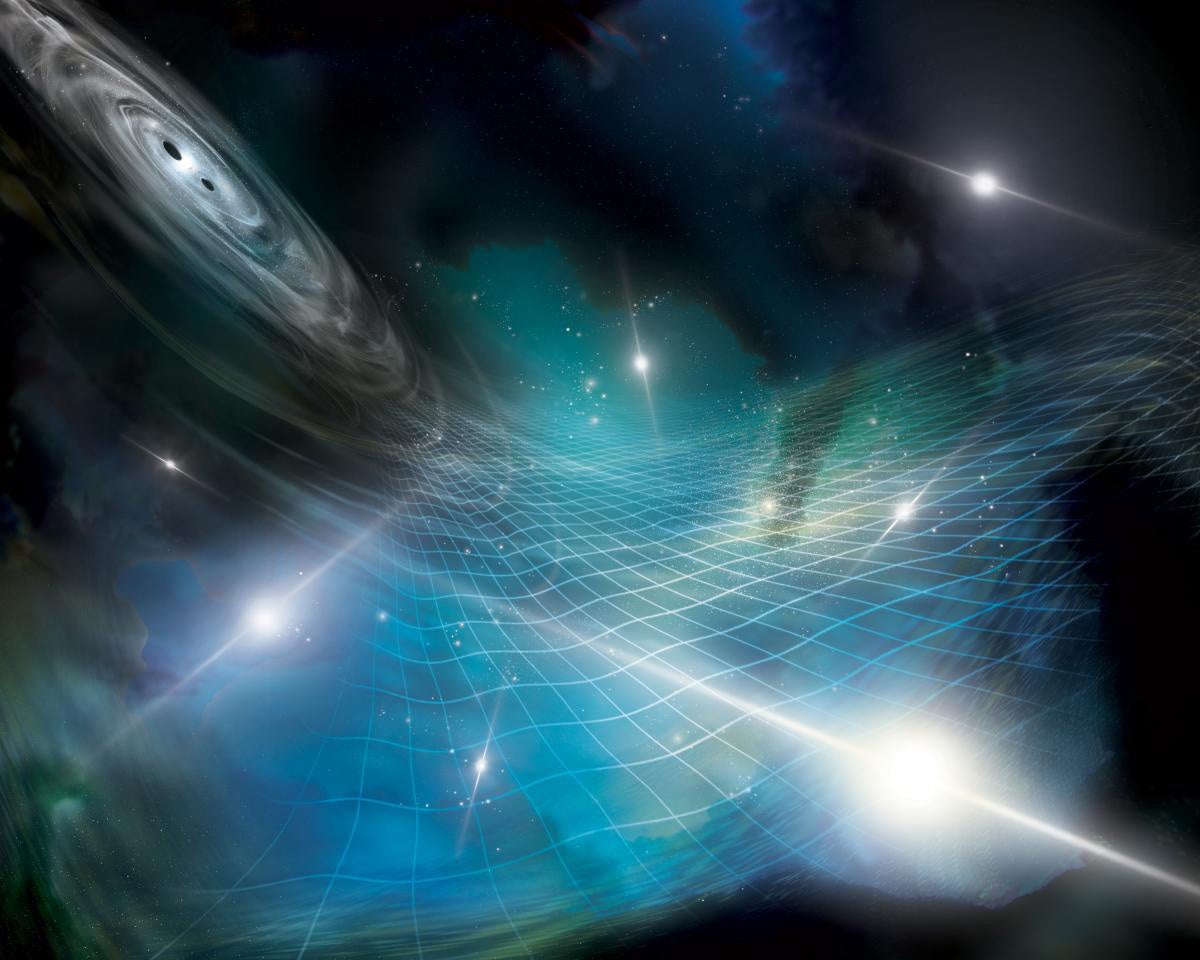
Astronomers listen in on the cosmos’ background hum
Gravitational waves are ripples in space-time that arise from extremely energetic events, such as the collisions of neutron stars or black holes. Since their first detection in 2016 by the Laser Interferometer Gravitational-wave Observatory (LIGO), gravitational waves have given us a new way to study the universe — and 2023 brought a fresh twist.
Scientists are limited to studying a narrow range of gravitational waves. That’s because their wavelength, or the distance between successive crests of each wave, is proportional to the masses of and the distance between the objects creating them. This means a pair of stars orbiting in a tight binary create shorter-wavelength gravitational waves than do merging supermassive black holes with millions or billions of times the mass of the Sun. In fact, supermassive black hole mergers can create gravitational waves with crests tens of light-years apart.
Detecting such long-wavelength gravitational waves is beyond current observatories like LIGO and Virgo, which only catch the high-pitched “chirps” of binary objects a few to about 100 times the Sun’s mass. These signals represent the last minutes or seconds of a merger, as the objects circle ever closer before slamming together, all the while releasing angular momentum as gravitational waves.
For supermassive black holes, this process plays out over a much greater span of time. When galaxies merge, their individual supermassive black holes sink to the center and eventually merge over some 100 million to 200 million years. During that time, other galaxies elsewhere in the universe will merge as well, and their black holes will begin their own hundred-million-year inward spiral.
“If there’s a lot of these [long-wavelength] gravitational-wave signals, they can add together and give you a gravitational-wave background,” said Yale University Assistant Professor of Physics Chiara Mingarelli in a video release. Mingarelli is part of the North American Nanohertz Observatory for Gravitational Waves (NANOGrav) collaboration, which announced the first-ever detection of this background June 29 in several papers in The Astrophysical Journal Letters.
Without instruments tuned to long wavelengths, the NANOGrav collaboration looked to fast-rotating neutron stars called pulsars. As a pulsar spins, it shoots beams of radiation from its poles; every revolution, these beams sweep over Earth like light from a lighthouse. The beams’ arrival is incredibly regular, down to a fraction of a second, turning each pulsar into its own highly accurate cosmic clock.
NANOGrav monitored a network of 67 pulsars throughout the Milky Way for 15 years, looking for tiny shifts in the timing of the arrival of their beams. These occur when a gravitational wave passes by, subtly squeezing or stretching the space-time between the pulsar and Earth, causing the signals to arrive slightly sooner or later than expected, respectively. “Like a huge ocean swell, the stars in our galaxy are all moving in concert to waves in space-time that take more than a decade just to complete one cycle of the wave,” says Kelly Holley-Bockelmann of Vanderbilt University, a gravitational-wave researcher who is not part of NANOGrav.
That’s why NANOGrav had to monitor the pulsars for so long. And it was worth it. The resulting pattern of timing disruptions matches exactly what is expected if there is a background of gravitational waves humming throughout the cosmos. “After years of work, NANOGrav is opening an entirely new window on the gravitational-wave universe,” said NANOGrav collaborator Stephen Taylor, also of Vanderbilt, in a statement.
The detection has now clinched the case that supermassive black holes do merge — previously a long-standing question in astrophysics. It has also revealed surprises: The gravitational-wave background is twice as loud as expected. Perhaps supermassive black holes are larger or more numerous than current estimates. But perhaps something previously unimagined is contributing to the volume as well. “We’ll need to keep observing to reveal the true nature of these gravitational waves,” says Holley-Bockelmann.
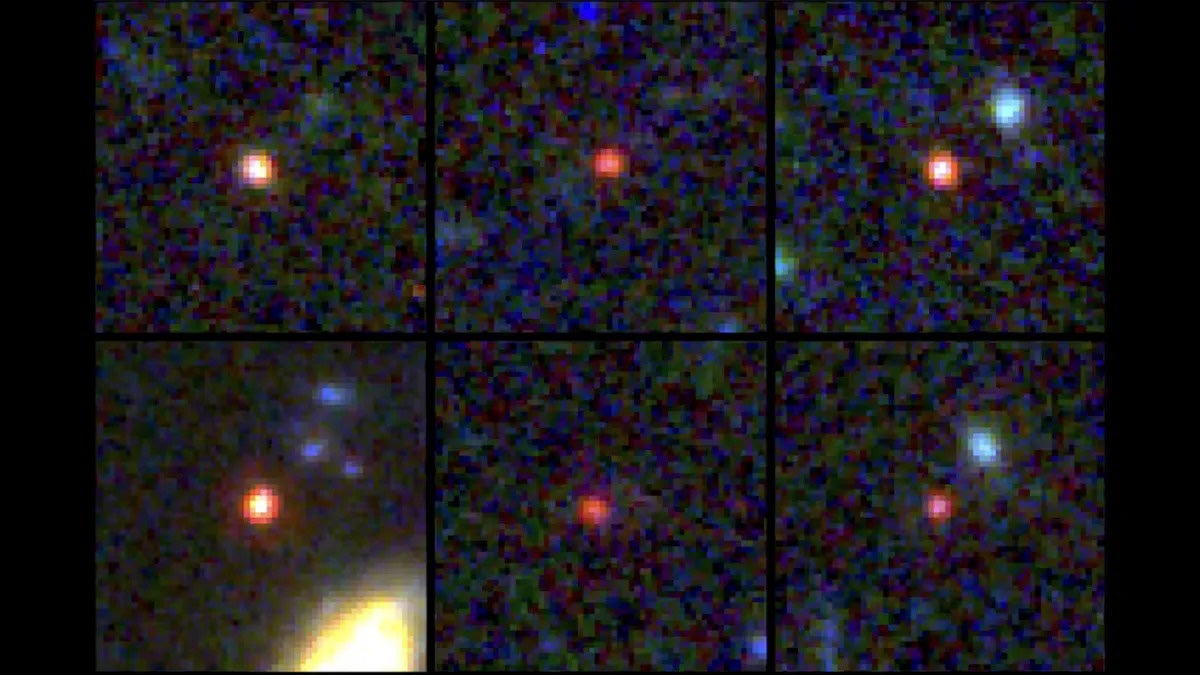
JWST spots potentially ‘universe-breaking’ galaxies
It should be no surprise that the James Webb Space Telescope (JWST), last year’s top story, has yet again made our list. With more than a full year of science under its belt, JWST has truly begun revolutionizing astronomy.
And it didn’t start small. Scientists analyzing JWST’s early images announced Feb. 22 in Nature that they’d identified some of the youngest galaxies now known: six of them, shining roughly 540 million to 770 million years after the Big Bang.
But these young galaxies didn’t look like they should. They were massive. Too massive, housing some 10 billion to 100 billion solar masses’ worth of stars. “These galaxies should not have had time to form,” based on our current understanding of how quickly matter in the early universe could conglomerate and form new suns, said study co-author Erica Nelson of the University of Colorado Boulder in a press release. “You just don’t expect the early universe to be able to organize itself that quickly.”
“The revelation that massive galaxy formation began extremely early in the history of the universe upends what many of us had thought was settled science,” added co-author Joel Leja of Penn State. “We’ve been informally calling these objects ‘universe breakers.’ ”
Is that it, then? Did JWST break the universe? Various groups have presented alternative explanations that rescue our current understanding of the cosmos. One, led by researchers at Saint Mary’s University in Halifax, Nova Scotia, argued that the galaxies’ redshifts, or distances, may not be as high as originally thought. That’s because the initial team didn’t look at the objects’ spectral features across all wavelengths, but instead took images in various filters at discrete wavelengths — a common alternate technique, but one prone to bias. The technique may also have picked out only the very biggest and brightest galaxies, which are not representative of the general population. And the Saint Mary’s University study warned against making broad statements about the early universe as a whole based on just a handful of examples. The work had been submitted to Monthly Notices of the Royal Astronomical Society but not yet peer-reviewed at the time of this writing.
Another study, published Oct. 3 in The Astrophysical Journal Letters, used simulations to show that brief, irregular bursts of furious star formation can temporarily make galaxies appear brighter. In other words, JWST may have imaged these galaxies during a short period when they were birthing lots of stars before calming down again. If this were the case, astronomers assuming a steady rate of star formation would overestimate the amount of stars these galaxies had created over time based on their artificially enhanced brightness. But such an effect has not yet been observed in real galaxies, so further investigation is still needed.
As for the original team, Leja noted that not all the objects — officially labeled galaxy “candidates” in the paper — might truly be galaxies after all. Instead, he proposed some may be accreting supermassive black holes called quasars, which can shine more brightly than the galaxy around them and confuse astronomers’ estimates for brightness, size, and mass. And initial follow-up studies did discover one of the six candidates is indeed a young quasar. Only additional work to characterize the remaining candidates will tell whether they are truly young, massive galaxies forming lots of stars when they shouldn’t be, or something else masquerading as such.
Still, said Nelson, “if even one of these galaxies is real, it will push against the limits of our understanding of cosmology.”

Credit: IceCube Collaboration/U.S. National Science Foundation (Lily Le & Shawn Johnson)/ESO (S. Brunier)
We view the Milky Way in neutrinos
The mottled Milky Way is a familiar sight in the night sky. And whether viewed in visible light, with a radio telescope, or even with high-energy gamma rays, the image comes to us via photons of light. But last year, astronomers finally saw our galaxy in an entirely different way: not with light, but with neutrinos. Their accomplishment was published June 29 in Science.
Sometimes called “ghost particles” because they rarely interact with other matter, neutrinos reveal where high-energy events are taking place. One region astronomers expected them to come from is the plane of the Milky Way. There, cosmic rays (themselves hallmarks of high-energy events) slamming into gas and dust produce gamma rays that have been previously spotted. Researchers believed these interactions should also produce neutrinos.
But spotting neutrinos takes a special setup. For that, there’s the IceCube Neutrino Observatory at the South Pole, with 5,000-plus sensors buried beneath the ultra-pure Antarctic ice. Arrayed over roughly 0.24 cubic mile (1 cubic kilometer), these detectors don’t see neutrinos directly, but instead key into the reaction that occurs when a neutrino does occasionally slam into an atom in the ice. The collision produces a slew of charged particles that cascade through the ice, generating a glow called Cherenkov radiation. Based on where and when each detector registers this glow, researchers can work backward to determine where on the sky the neutrino came from.
Although IceCube had previously detected neutrinos from outside our galaxy, finding those originating within the Milky Way has been difficult. That’s because neutrinos from far-off galaxies leave straight, easy-to-trace showers of light when they smack into the ice. To detect neutrinos produced inside the Milky Way, the team instead focused on tracks that were more like spherical blobs; these are harder to trace back to their origin and had typically gone ignored. That is, until a team developed a machine-learning algorithm to comb through a decade of readings, analyzing more than 60,000 detections for details such as position and energy. This helped differentiate between neutrinos produced in galactic dust and gas, and those commonly created when cosmic rays hit Earth’s atmosphere.
The result was a map of the Milky Way in neutrinos — our first glimpse of our galaxy in anything other than light.
That map matches well those produced using gamma rays, as astronomers hoped. And within that map, there are hints of not only neutrinos from gas and dust, but possibly smaller sources — such as black holes and neutron stars — as well. Teasing out those sources is one of the team’s future goals.
“Observing our own galaxy for the first time using particles instead of light is a huge step,” said Naoko Kurahashi Neilson, an IceCube team member at Drexel University in Philadelphia, in a release. “As neutrino astronomy evolves, we will get a new lens with which to observe the universe.”
Stories to watch for in 2024
- The launch window for NASA’s Europa Clipper, a mission seeking out habitable regions beneath that icy jovian moon’s surface, opens Oct. 10, 2024.
- ESA’s Hera spacecraft will launch in October 2024 to study the binary asteroids Didymos and Dimorphos, the latter of which was impacted by NASA’s Double Asteroid Redirection Test (DART) in September 2022 (middle).
- ESA’s BepiColombo mission will fly by Mercury twice in 2024, on Sept. 5 and Dec. 2.
- A total solar eclipse will cross parts of Mexico, the U.S., and Canada on April 8, 2024, with tens of millions of people living in the path of totality (bottom).









